1994 CHEVROLET S10 service
[x] Cancel search: servicePage 250 of 340
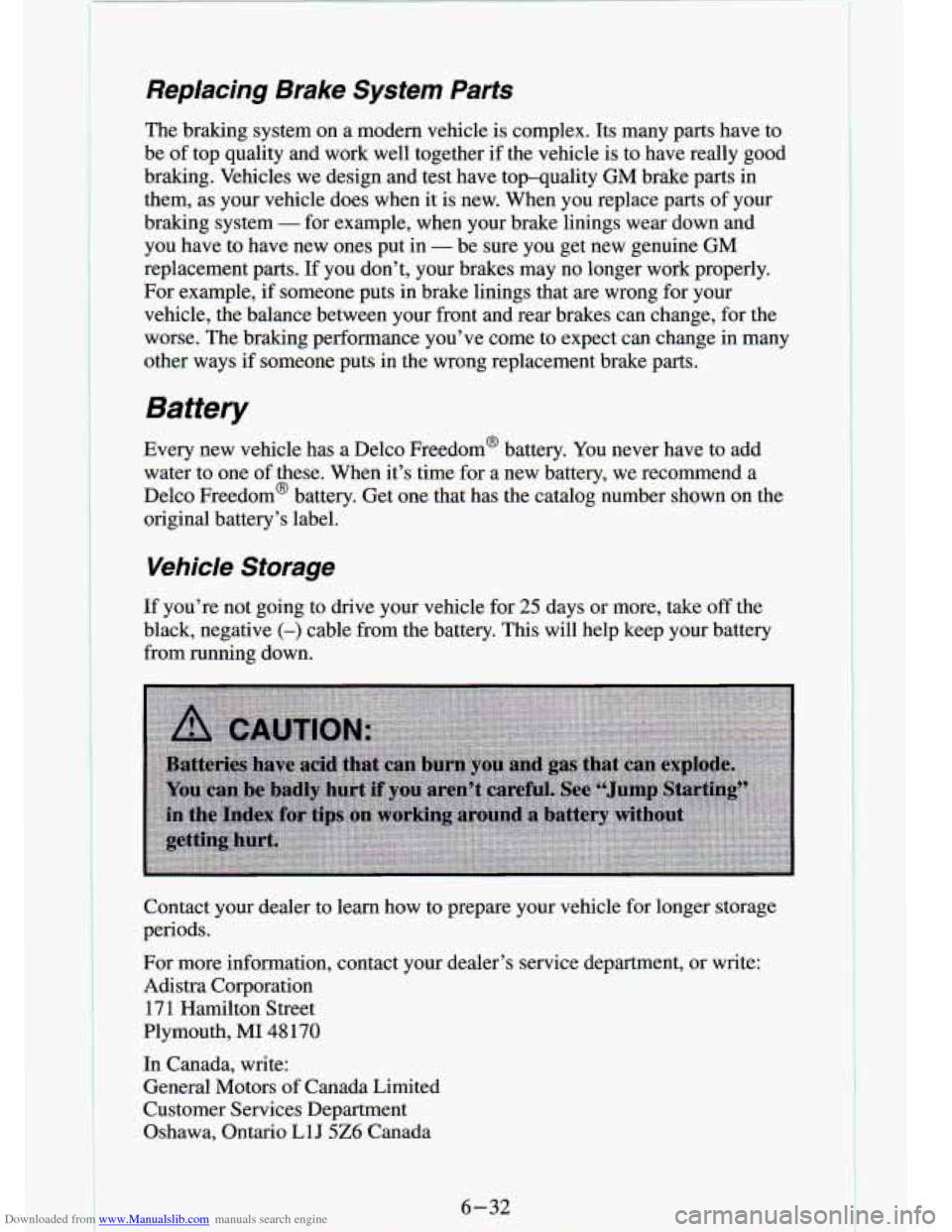
Downloaded from www.Manualslib.com manuals search engine Replacing Brake System Parts
The braking system on a modern vehicle is complex. Its many parts have to
be of top quality and work well together if the vehicle is to have \
really good
braking. Vehicles
we design and test have topquality GM brake parts in
them, as your vehicle does when it is new. When you replace parts of your
braking system
- for example, when your brake linings wear down and
you have to have new ones put in
- be sure you get new genuine GM
replacement parts. If you don’t, your brakes may no longer work properly.
For example, if someone puts in brake linings that are wrong \
for your vehicle, the balance between your front and rear brakes can change, for the
worse. The braking performance you’ve come to expect can change in many
other ways if someone puts in the wrong replacement brake parts.
Battery
Every new vehicle has a Delco Freedom@ battery. You never have to add
water to one of these. When it’s time for a new battery,
we recommend a
Delco Freedom’ battery. Get one that has the catalog number shown on the
original battery’s label.
Vehicle Storage
If you’re not going to drive your vehicle for 25 days or more, take off the
black, negative
(-) cable from the battery. This will help keep your battery
from running down.
Contact your dealer to learn how to prepare your vehicle for longer storage
periods.
For more information, contact your dealer’s service department\
, or write: Adistra Corporation
171 Hamilton Street
Plymouth,
MI 48 170
In Canada, write:
General Motors
of Canada Limited
Customer Services Department
Oshawa, Ontario
L1J 5Z6 Canada
6-32
!
Page 261 of 340
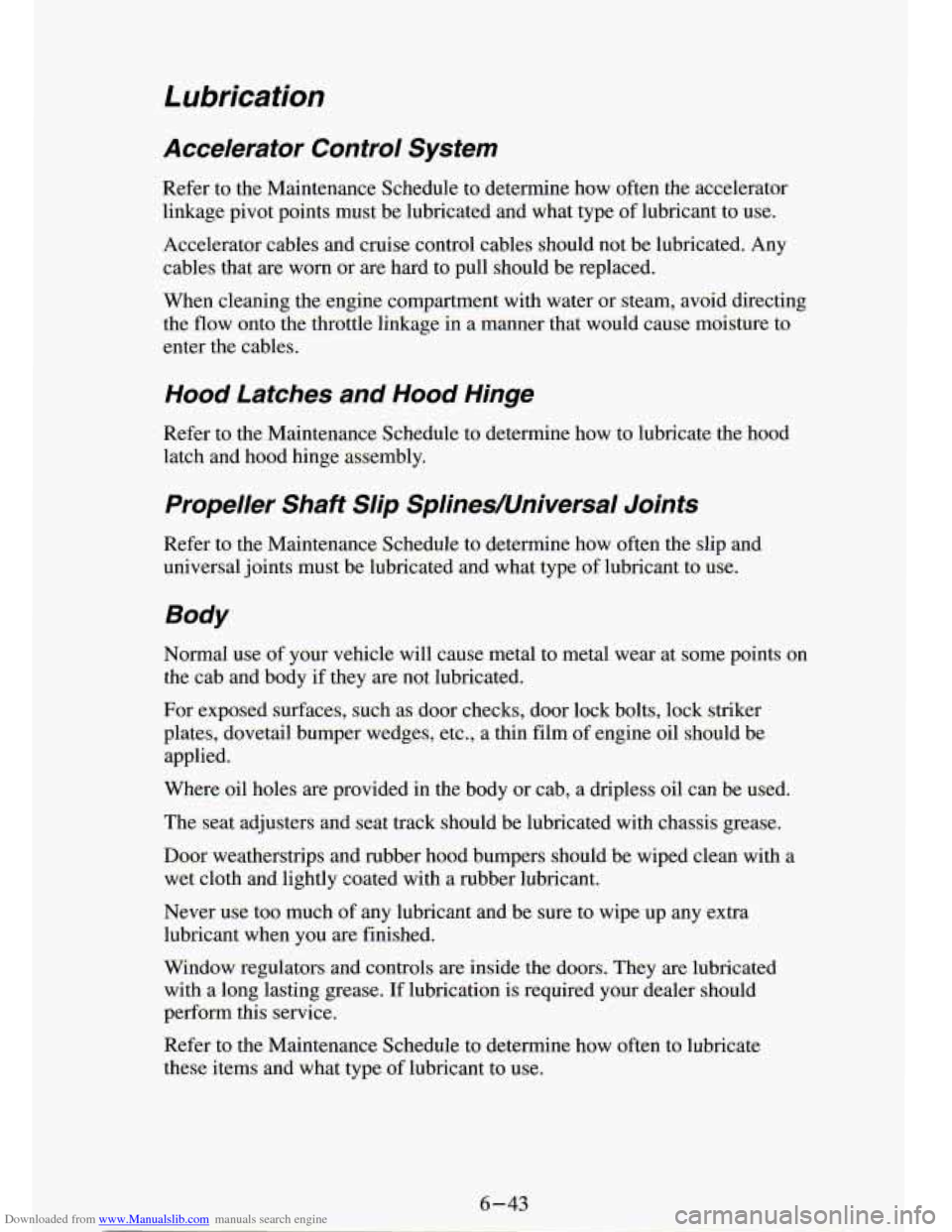
Downloaded from www.Manualslib.com manuals search engine Lubrication
Accelerator Control System
Refer to the Maintenance Schedule to determine how often the a\
ccelerator linkage pivot points must be lubricated and what type
of lubricant to use.
Accelerator cables and cruise control cables should not be lubr\
icated. Any
cables that are worn or are hard
to pull should be replaced.
When cleaning the engine compartment with water or steam, avoid\
directing the flow onto the throttle linkage
in a manner that would cause moisture to
enter the cables.
Hood Latches and Hood Hinge
Refer to the Maintenance Schedule to determine how to lubricate\
the hood
latch and hood hinge assembly.
Propeller Shaft Slip Splines/Universal Joints
Refer to the Maintenance Schedule to determine how often the slip and
universal joints must be lubricated and what type
of lubricant to use.
Body
Normal use of your vehicle will cause metal to metal wear at some points on
the cab and body if they are not lubricated.
For exposed surfaces, such as door checks, door lock bolts, lock s\
triker
plates, dovetail bumper wedges, etc., a thin film
of engine oil should be
applied.
Where oil holes are provided in the body or cab, a dripless oil can be used.
The seat adjusters and seat track should be lubricated with chassis\
grease.
Door weatherstrips and rubber hood bumpers should be wiped clea\
n with a wet cloth and lightly coated with a rubber lubricant.
Never use too much
of any lubricant and be sure to wipe up any extra
lubricant when you are finished.
Window regulators and controls are inside the doors. They are lubricated
with a long lasting grease.
If lubrication is required your dealer should
perform this service.
Refer to the Maintenance Schedule to determine how often to lubricate
these items and what type of lubricant to use.
Page 262 of 340
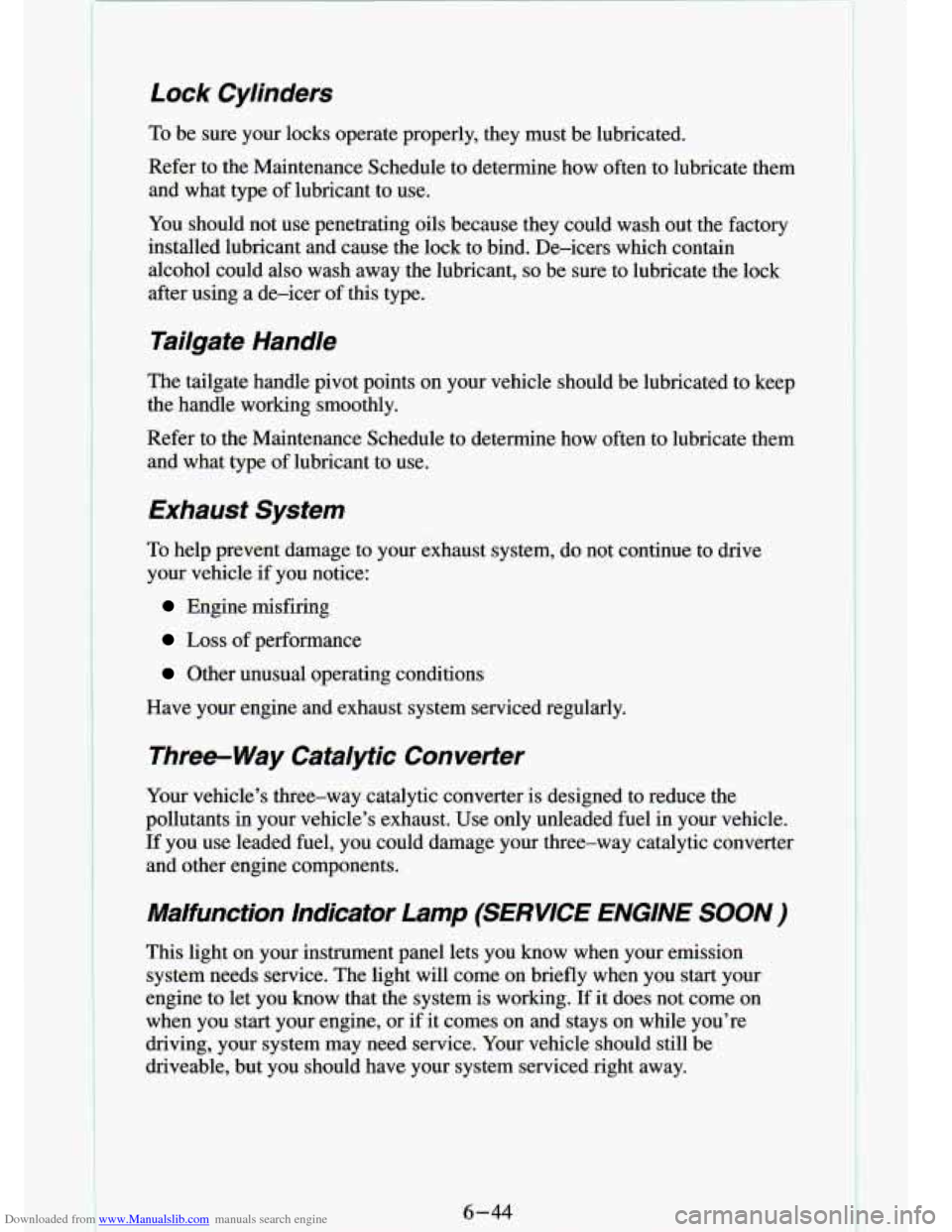
Downloaded from www.Manualslib.com manuals search engine Lock Cylinders
To be sure your locks operate properly, they must be lubricated.
Refer to the Maintenance Schedule to determine
how often to lubricate them
and what type
of lubricant to use.
You should not use penetrating oils because they could wash out the factory
installed lubricant and cause
the lock to bind. De-icers which contain
alcohol could
also wash away the lubricant, so be sure to lubricate the lock
after using a de-icer of this type.
Tailgate Handle
The tailgate handle pivot points on your vehicle should be lubricated to keep
the handle working smoothly.
Refer to the Maintenance Schedule to determine
how often to lubricate them
and what type
of lubricant to use.
Exhaust System
To help prevent damage to your exhaust system, do not continue to drive
your vehicle if you notice:
Engine misfiring
Loss of performance
Other unusual operating conditions
Have your engine and exhaust system serviced regularly.
Three- Way Catalytic Converter
Your vehicle's three-way catalytic converter is designed to reduce the
pollutants in your vehicle's exhaust. Use only unleaded fuel in your vehicle.
If you use leaded fuel, you could damage your three-way catalytic converter
and other engine components.
Malfunction Indicator Lamp (SERVICE ENGINE SOON )
This light on your instrument panel lets you know when your emission
system needs service. The light will come on briefly when you start your
engine to let you know that the system
is working. If it does not come on
when you start your engine, or if it comes on and stays on while you're
driving, your system may
need service. Your vehicle should still be
driveable, but you should have your system serviced right away.
6-44
Page 272 of 340
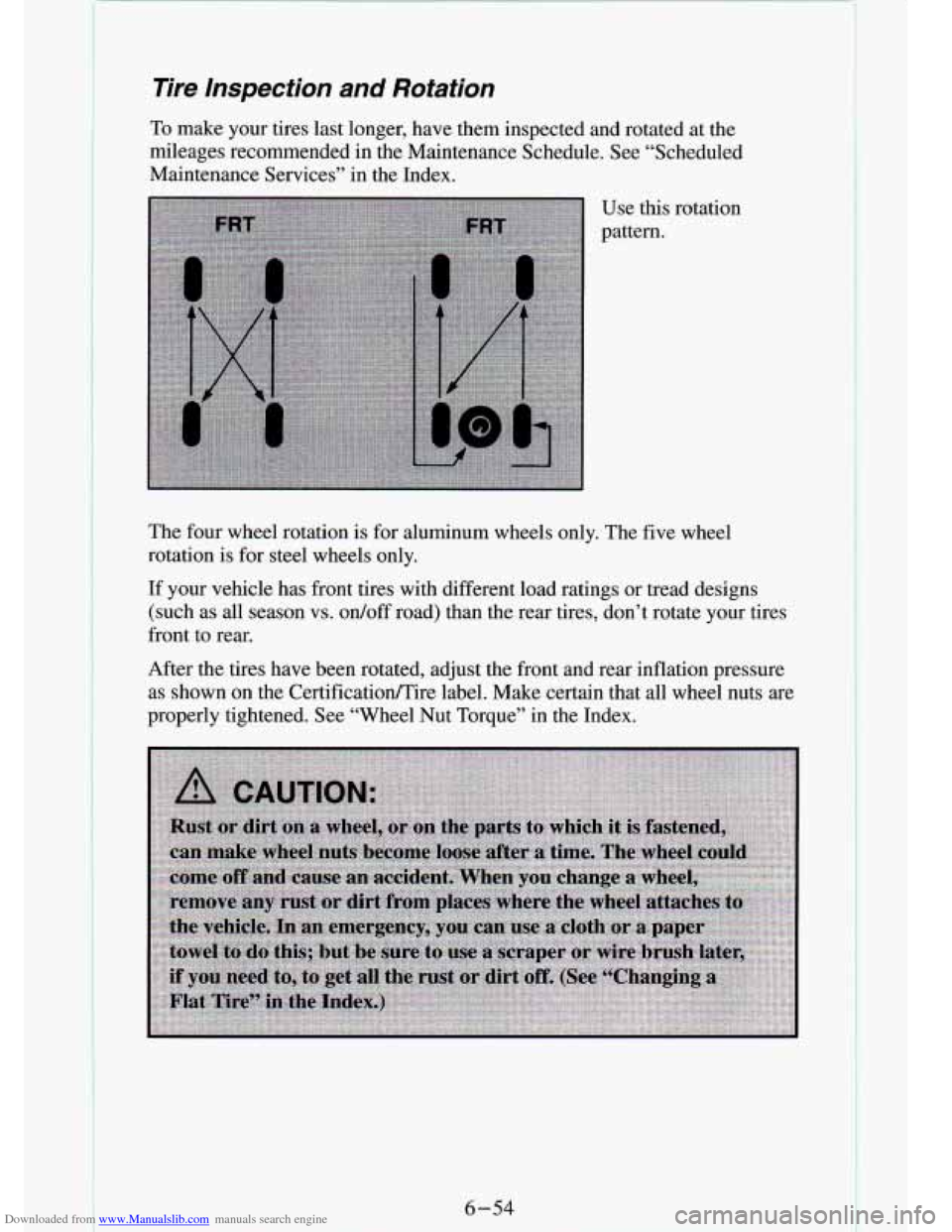
Downloaded from www.Manualslib.com manuals search engine lire Inspection and Rotation
To make your tires last longer, have them inspected and rotated at the
mileages recommended in the Maintenance Schedule. See “Schedul\
ed
Maintenance Services” in the Index.
Use this rotation
pattern.
The four wheel rotation is for aluminum wheels only. The five wheel
rotation is for steel wheels only.
If your vehicle has front tires with different load ratings or tr\
ead designs
(such as all season vs. ordoff road) than the rear tires, d\
on’t rotate your tires
front to rear.
After the tires have been rotated, adjust the front and rear inflation pressure
as shown on the CertificatiodTire label. Make certain that all wheel nuts are
properly tightened. See “Wheel Nut Torque” in the Index.
6-54
Page 273 of 340
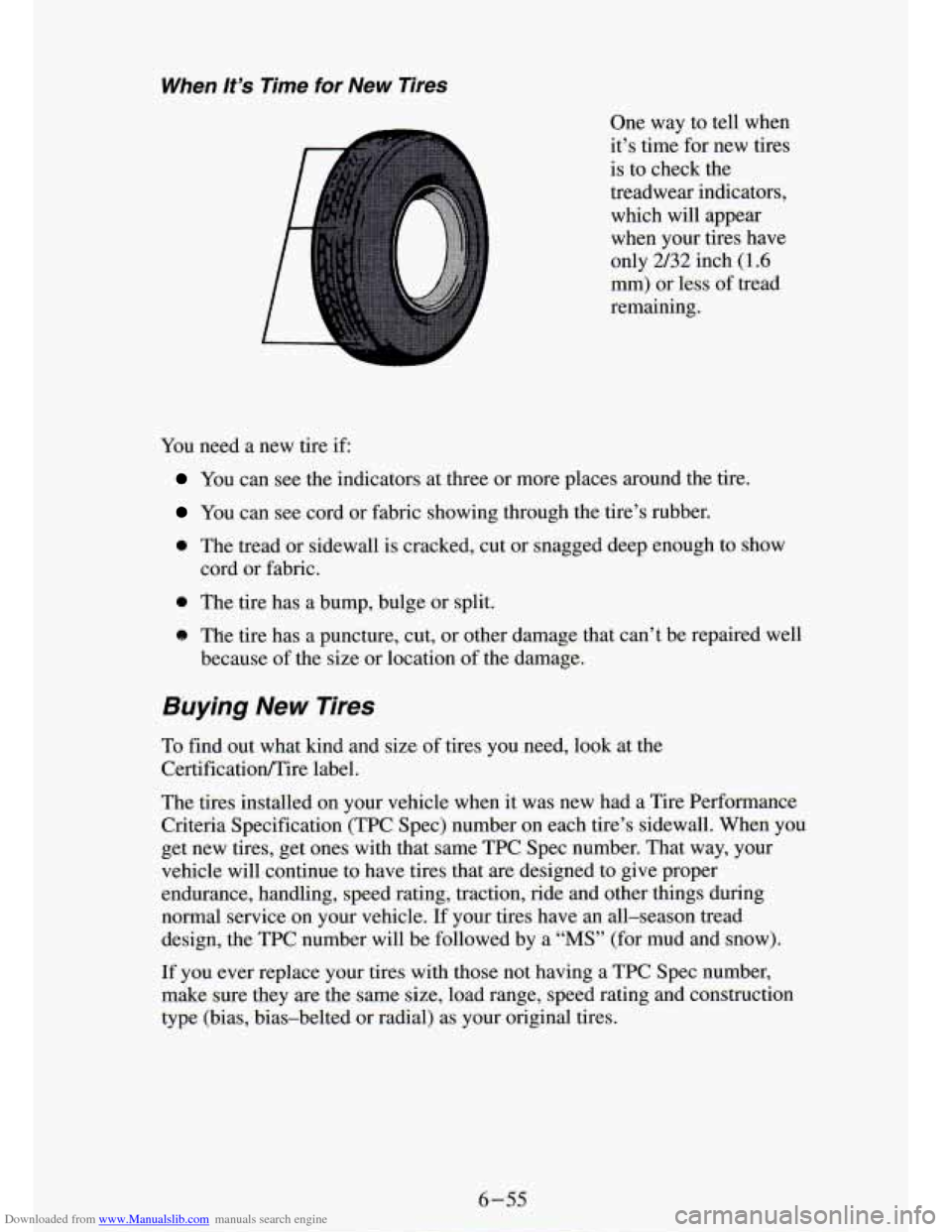
Downloaded from www.Manualslib.com manuals search engine When lt’s Time for New Tires
a
One way to tell when
it’s time for new tires
is to check the
treadwear indicators,
which will appear
when your tires have
only
2/32 inch (1.6
mm) or less of tread
remaining.
You need a new tire if
You can see the indicators at three or more places around the tire.
You can see cord or fabric showing through the tire’s rubber.
0 The tread or sidewall is cracked, cut or snagged deep enough to show
cord or fabric.
0 The tire has a bump, bulge or split.
The tire has a puncture, cut, or other damage that can’t be re\
paired well
because of the
size or location of the damage.
Buying New Tires
To find out what kmd and size of tires you need, look at the
Certificatioflire label.
The tires installed on your vehicle when it was new had a Tire Performance
Criteria Specification (PC Spec) number on each tire’s sidewall. When you
get new tires, get ones with that same TPC Spec number. That way, your
vehicle will continue to have tires that
are designed to give proper
endurance, handling, speed rating, traction, ride and other thin\
gs during
normal service on your vehicle.
If your tires have an all-season tread
design, the TPC number will be followed by a
“MS” (for mud and snow).
If you ever replace your tires with those not having a
TPC Spec number,
make sure they are the same size, load range, speed rating and construction
type (bias, bias-belted or radial) as your original tires.
Page 274 of 340
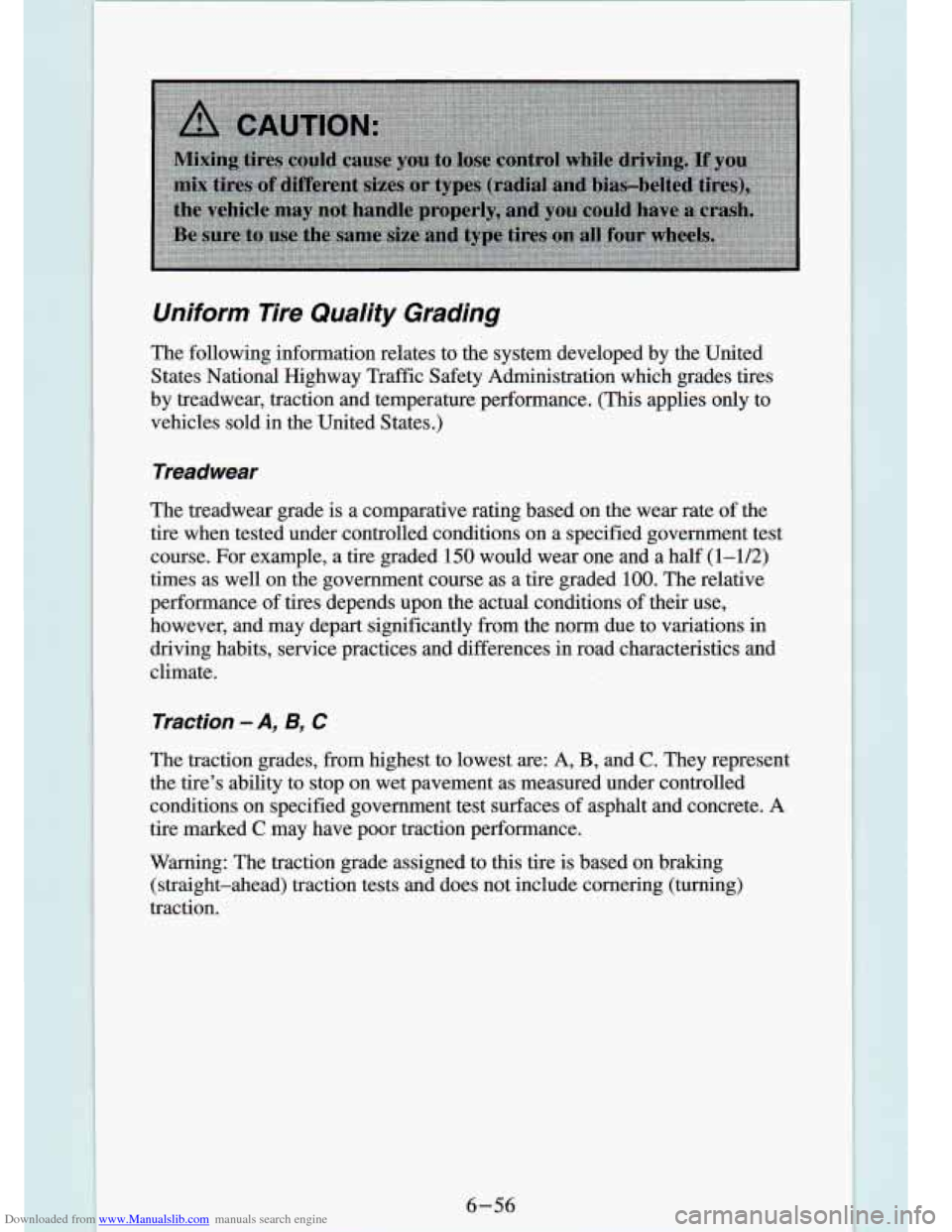
Downloaded from www.Manualslib.com manuals search engine Uniform Tire Quality Grading
The following information relates to the system developed by the Un\
ited
States National Highway Traffic Safety Administration which grade\
s tires
by treadwear, traction and temperature performance. (This applie\
s only
to
vehicles sold in the United States.)
Treadwear
The treadwear grade is a comparative rating based on the wear rate\
of the
tire when tested under controlled conditions on a specified gov\
ernment test
course. For example, a tire graded
150 would wear one and a half (1-1/2)
times as well on the government course as a tire graded 100. The relative
performance of tires depends upon the actual conditions
of their use,
however, and may depart significantly from the norm due to var\
iations
in
driving habits, service practices and differences in road charac\
teristics and
climate.
Tractlon - A, 9, C
The traction grades, from highest to lowest are: A, B, and C. They represent
the tire’s ability
to stop on wet pavement as measured under controlled
conditions on specified government test surfaces of asphalt and concrete.
A
tire marked C may have poor traction performance.
Warning: The traction grade assigned to this tire is based on braking
(straight-ahead) traction tests
and does not include cornering (turning)
traction.
6-56
Page 284 of 340
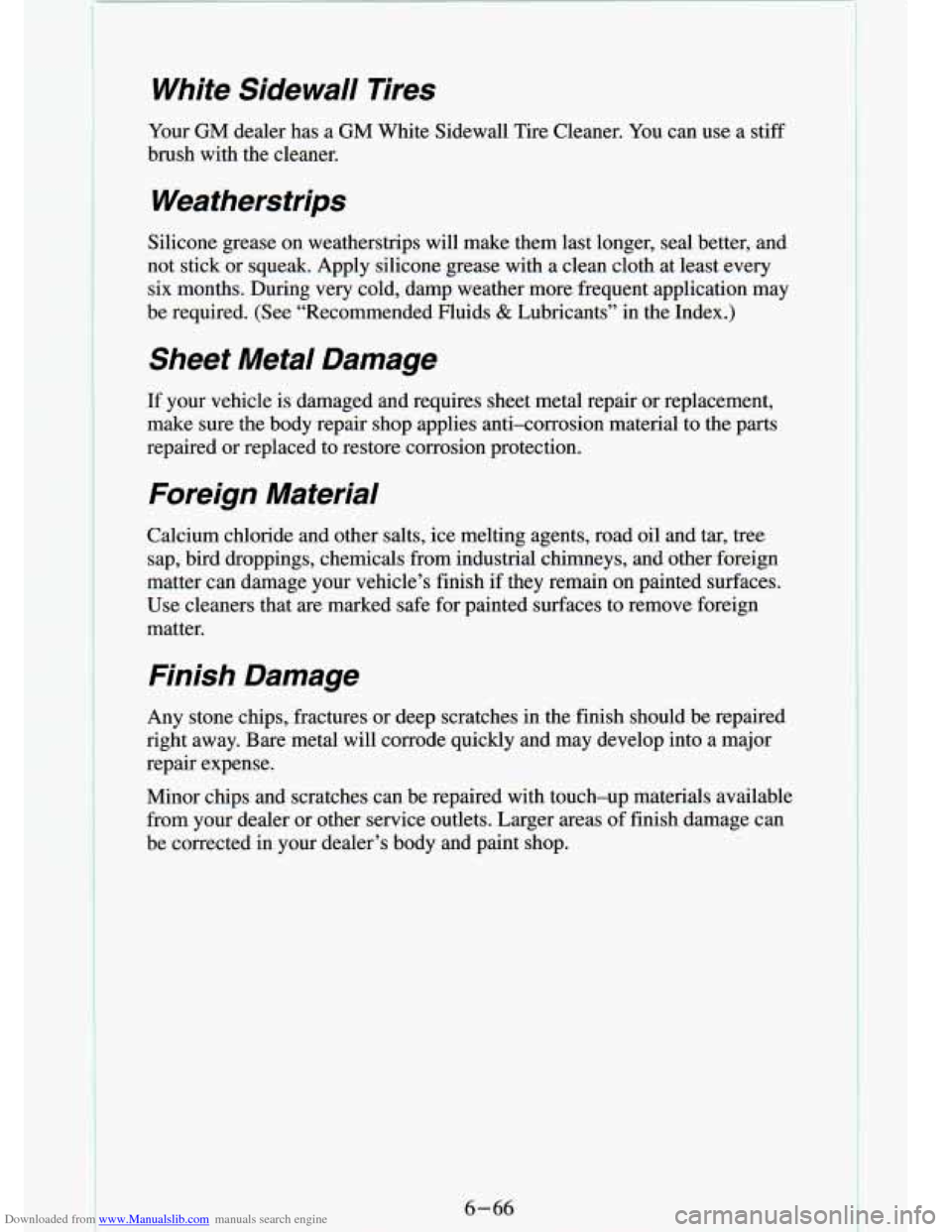
Downloaded from www.Manualslib.com manuals search engine White Sidewall Tires
..
Your GM dealer has a GM White Sidewall Tire Cleaner. You can use a stiff
brush with the cleaner.
Weatherstrips
Silicone grease on weatherstrips will make them last longer, se\
al better, and
not stick or squeak. Apply silicone grease with a clean cloth \
at least every
six months. During very cold, damp weather more frequent application\
may
be required. (See “Recommended Fluids
& Lubricants” in the Index.)
Sheet Metal Damage
If your vehicle is damaged and requires sheet metal repair or rep\
lacement,
make sure the body repair shop applies anti-corrosion material to the parts
repaired
or replaced to restore corrosion protection.
Foreign Material
Calcium chloride and other salts, ice melting agents, road oil and tar, tree
sap, bird droppings, chemicals from industrial chimneys, and other foreign
matter can damage your vehicle’s finish if they remain on p\
ainted surfaces.
Use cleaners that are marked safe for painted surfaces to remove foreign
matter.
Finish Damage
Any stone chips, fractures or deep scratches in the finish sho\
uld be repaired
right away. Bare metal will corrode quickly and may develop in\
to a major
repair expense.
Minor chips and scratches can be repaired with touch-up materia\
ls available
from your dealer or other service outlets. Larger areas of finish damage can
be corrected in your dealer’s body and paint shop.
6-66
Page 286 of 340
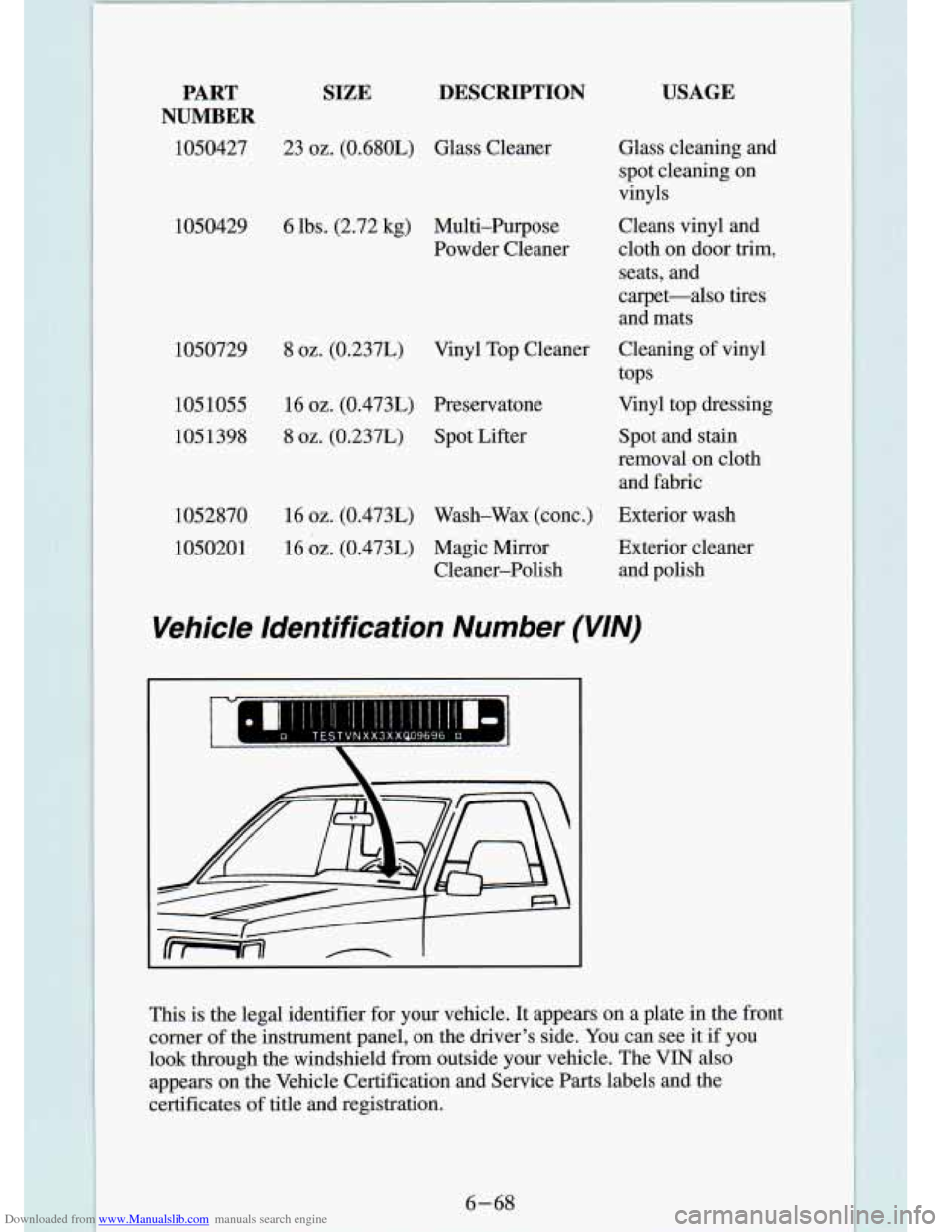
Downloaded from www.Manualslib.com manuals search engine PART
NUMBER
1050427
SIZE DESCRIPTION
23 oz. (0.680L) Glass Cleaner
1050429 6 lbs. (2.72 kg) Multi-Purpose Powder Cleaner
1050729
USAGE
Glass cleaning and spot cleaning on
vinyls
Cleans vinyl and
cloth on door
trim,
seats, and
carpet-also tires
and mats
8 oz. (0.237L) Vinyl Top Cleaner Cleaning of vinyl
tops
1051055 16
oz. (0.473L) Preservatone
1051398
8 oz. (0.237L) Spot Lifter Vinyl top dressing
Spot and stain
removal on cloth
and fabric
1052870 16
oz. (0.473L) Wash-Wax (conc.) Exterior wash
1050201 16
oz. (0.473L) Magic Mirror Cleaner-Polish Exterior cleaner
and polish
Vehicle Identification Number (VIN)
I
This is the legal identifier for your vehicle. It appears on a plate in the front
corner
of the instrument panel, on the driver's side. You can see it if you
look through the windshield from outside your vehicle. The
VIN also
appears on the Vehicle Certification and Service Parts labels a\
nd the
certificates of title and registration.